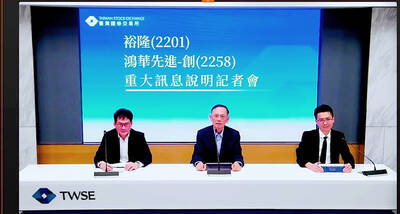The Chung-Hua Institution for Economic Research (CIER, 中華經濟研究院) yesterday raised its forecast for the nation’s GDP growth this year to 1.76 percent, from its previous estimate of 1.33 percent, saying exports and private consumption have staged a V-shaped recovery from the COVID-19 pandemic in the second half of the year.
“The upgrade aims to reflect the fast recovery in Taiwan’s exports and domestic demand,” CIER president Chang Chuang-chang (張傳章) told a media briefing.
The Taipei-based think tank said the economy might have expanded 2.77 percent last quarter — emerging from a 0.78 percent decline in the second quarter — and would grow 2.55 percent this quarter.

Photo: Wu Chia-ying, Taipei Times
The showing is impressive, making Taiwan one of the few economies reporting growth as COVID-19 infections surge in many parts of the world, threatening economic activity, the institute said.
Local technology firms have benefited from strong demand for 5G deployment and electronic devices required for a low-contact economy as well as rush orders and order transfers amid US-China tensions, CIER said.
China’s Huawei Technologies Co (華為) avidly stockpiled electronics inventory ahead of the Sept. 15 sales ban imposed by Washington due to national security concerns.
Outbound shipments might have increased 3.86 percent last quarter and would likely gain 2.59 percent in the current quarter from their year-ago levels, CIER said.
Imports would be soft for the whole of this year, due to lower fuel and raw material prices, allowing net external demand to contribute 0.82 percentage points to GDP growth this year, it said.
Domestically, private investment is likely to rise 2.55 percent from last year, aided by companies returning from China, and efforts by local tech firms to expand and maintain technology leadership, CIER said.
The government and public enterprises would lend support by raising their investments by 10.88 percent and 26.39 percent year-on-year respectively, it said.
Active investments would offset weak private consumption, a key GDP component that would stay in negative territory this year, despite a rapid recovery from the third quarter onward, it said.
CIER expects the New Taiwan dollar to trade at an average of NT$29.76 against the US dollar for the year, compared with yesterday’s closing rate of NT$28.932.
Central bank Governor Yang Chin-long (楊金龍) last week told lawmakers that the NT dollar would likely trade above NT$29 per US dollar in the coming six to 12 months, bolstered mainly by strong exports.
CIER forecast the unemployment rate to hover at about 3.99 percent and consumer prices to contract 0.2 percent this year, with the virus infections, US elections and other geopolitical risks creating uncertainty.

CHIP RACE: Three years of overbroad export controls drove foreign competitors to pursue their own AI chips, and ‘cost US taxpayers billions of dollars,’ Nvidia said China has figured out the US strategy for allowing it to buy Nvidia Corp’s H200s and is rejecting the artificial intelligence (AI) chip in favor of domestically developed semiconductors, White House AI adviser David Sacks said, citing news reports. US President Donald Trump on Monday said that he would allow shipments of Nvidia’s H200 chips to China, part of an administration effort backed by Sacks to challenge Chinese tech champions such as Huawei Technologies Co (華為) by bringing US competition to their home market. On Friday, Sacks signaled that he was uncertain about whether that approach would work. “They’re rejecting our chips,” Sacks

Taiwan’s long-term economic competitiveness will hinge not only on national champions like Taiwan Semiconductor Manufacturing Co. (TSMC, 台積電) but also on the widespread adoption of artificial intelligence (AI) and other emerging technologies, a US-based scholar has said. At a lecture in Taipei on Tuesday, Jeffrey Ding, assistant professor of political science at the George Washington University and author of "Technology and the Rise of Great Powers," argued that historical experience shows that general-purpose technologies (GPTs) — such as electricity, computers and now AI — shape long-term economic advantages through their diffusion across the broader economy. "What really matters is not who pioneers

In a high-security Shenzhen laboratory, Chinese scientists have built what Washington has spent years trying to prevent: a prototype of a machine capable of producing the cutting-edge semiconductor chips that power artificial intelligence (AI), smartphones and weapons central to Western military dominance, Reuters has learned. Completed early this year and undergoing testing, the prototype fills nearly an entire factory floor. It was built by a team of former engineers from Dutch semiconductor giant ASML who reverse-engineered the company’s extreme ultraviolet lithography (EUV) machines, according to two people with knowledge of the project. EUV machines sit at the heart of a technological Cold

TAIWAN VALUE CHAIN: Foxtron is to fully own Luxgen following the transaction and it plans to launch a new electric model, the Foxtron Bria, in Taiwan next year Yulon Motor Co (裕隆汽車) yesterday said that its board of directors approved the disposal of its electric vehicle (EV) unit, Luxgen Motor Co (納智捷汽車), to Foxtron Vehicle Technologies Co (鴻華先進) for NT$787.6 million (US$24.98 million). Foxtron, a half-half joint venture between Yulon affiliate Hua-Chuang Automobile Information Technical Center Co (華創車電) and Hon Hai Precision Industry Co (鴻海精密), expects to wrap up the deal in the first quarter of next year. Foxtron would fully own Luxgen following the transaction, including five car distributing companies, outlets and all employees. The deal is subject to the approval of the Fair Trade Commission, Foxtron said. “Foxtron will be